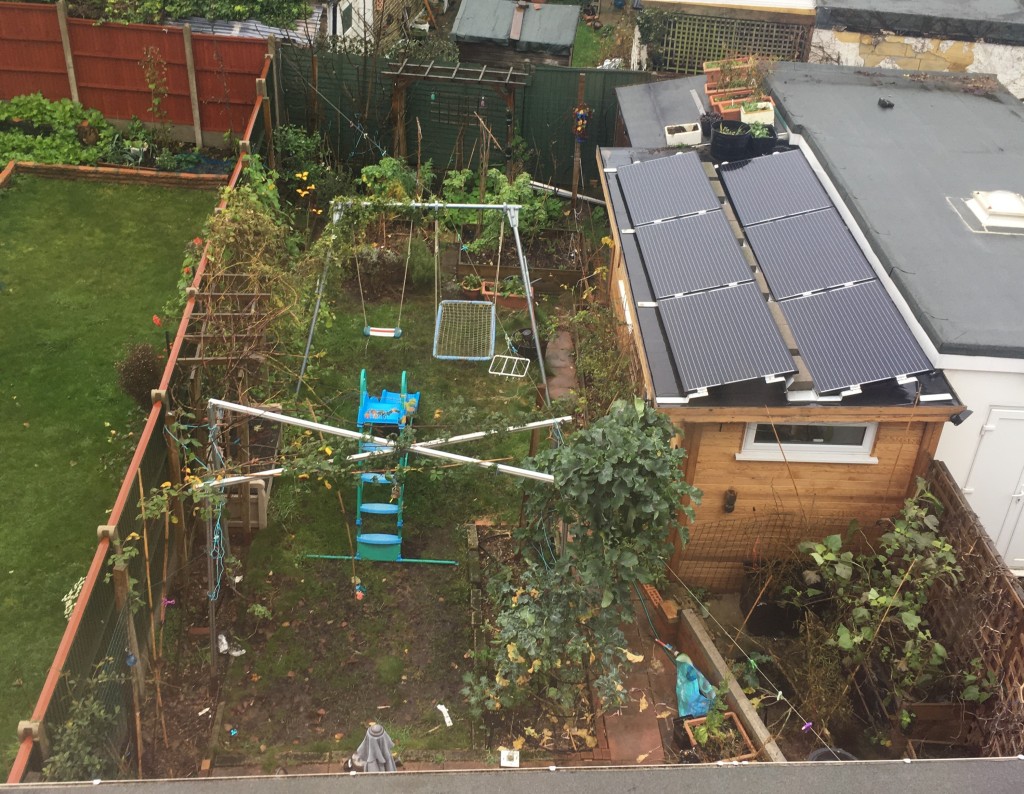
Short version:
It is easier to eat seasonally in the summer and autumn, but hopefully this week’s blog can give you some ideas about what you could grow in a UK garden (and maybe other northern hemisphere areas) over winter… which seems like a good idea when you see the news full of Brexit, lockdowns and of course becoming more sustainable is on my mind anyway after last week’s climate change blog.
Last week’s climate change blog inspired a panic of ‘MUST GROW MORE FOOD’!!! This week’s lockdown announcements also inspired a panic of ‘MUST GROW MORE FOOD’!!! Whilst this is still true, after assessing the garden in its current state, I realised how many things there were still in the garden to eat, even in January. The quantities are not so great, but the variety isn’t bad. It was actually one of my goals this year – to try and create a garden that would feed us more through the winter. In the summer, every day, we can pop out into the garden and bring something back to eat. there is a time, during the summer (changes depending on what we plant and how the weather is behaving) when we can eat fresh fruit and veg solely from the garden. Whilst I don’t think this is achievable for the winter, it would be fabulous if we could, at least, supplement our food shop with food from the garden. Currently we get maybe 4 or 5 meals a week that have garden vegetables. Sadly, this won’t last into February, but below is what we have been able to eat this winter so far. All of the photos were taken this month, though most were taken this week.
Persistent perennials:
Purple tree collard – This is fabulous brassica and has grown huge (it was 10ft, now pruned to 8ft). We’ve mostly ignored it over the summer so now there is still plenty to harvest. The leaves are a bit tough, but that is remedied with some longer cooking times. It’s not as prone to powdery mildew as the Daubenton’s kale and as the weather turned some of the went leaves yellow. It does benefit from frequent harvesting to allow for more air circulation. Highly recommend this for large amounts of winter (and hungry gap) food. It also produces a lot for the amount of soil space that it takes up. It tastes great as kale crisps. Click for more info.
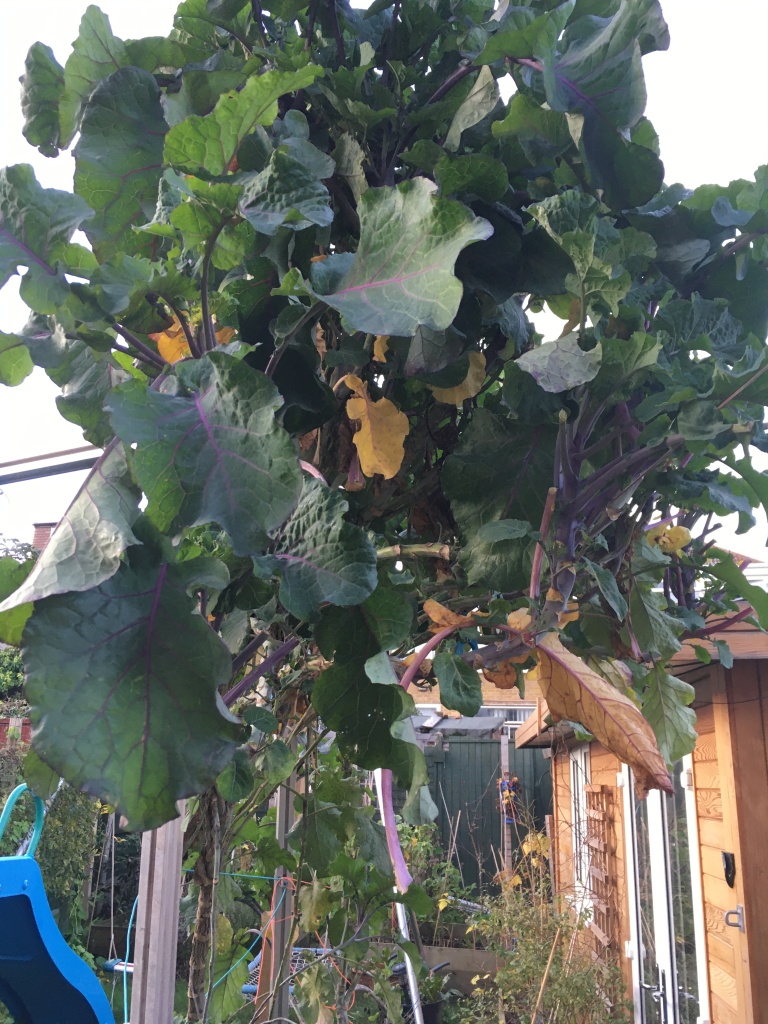
Before pruning 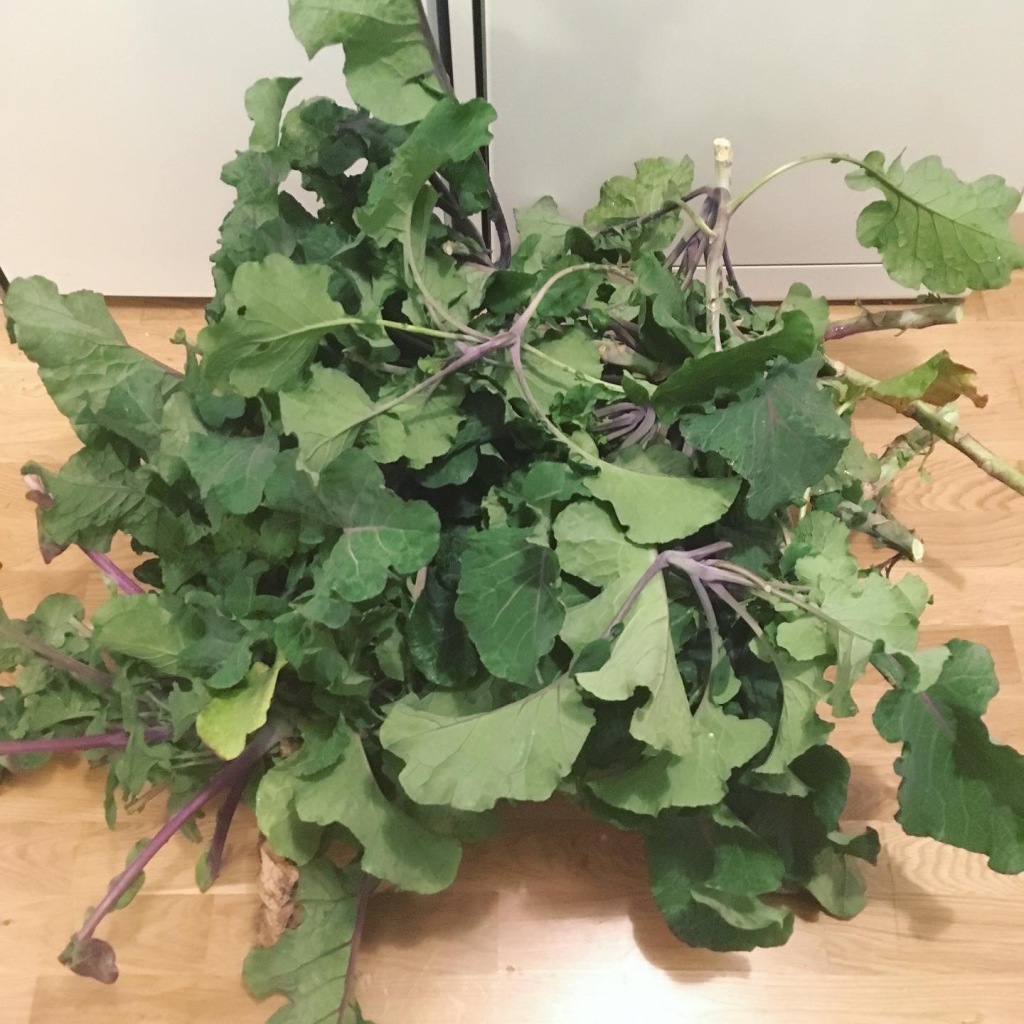
Eating the prunings has taken 5 meals so far. 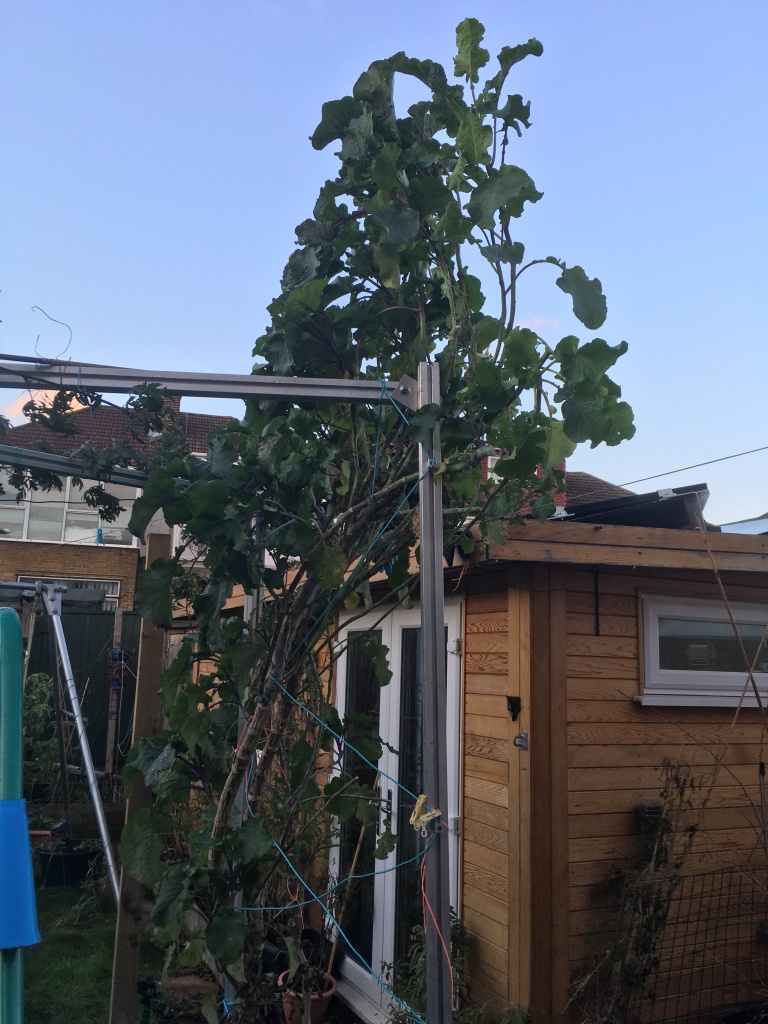
Still need to take another foot off the top
Daubentons kale – we do have a problem in the summer with powdery mildew, especially when it gets really hot and humid. We have lost much of the growth this year and have had to chop it back quite severely, but this does much better in the winter. The growth is slow, but this, like the purple tree collard, does produce a lot of food for the space it takes. Click for more info.
Watercress – It’s refreshing to have a leaf that doesn’t taste similar to brassicas. The only problem is that it really is slow growing. It also takes up quite a lot of soil space. Click for more info.
Physalis – this evergreen bushy plant still has plenty of fruit growing on it through winter. The fruit doesn’t mature so quickly when the weather is cold, but the berries are a welcome fruit when there is no other fruit available in our garden. Click for more info.
Three cornered leek – It is illegal to plant it in public spaces because of what a nuisance it can become. Therefore, I was very careful with planting it in a border surrounded by walls and flagstones where it wouldn’t escape. I also planted it sparsely. It has self-seeded and spread very well. I have also grown it in the very shadiest spot, under the physalis bush. There’s enough for a couple of meals but hopefully next year this space will be totally full, and I can harvest it into submission. I do wonder if it would make a good winter substitute for grass. The only reason I haven’t (yet) is that in the summer it dies back completely so we would have a lot of bare earth that cats would just poo on. Click for more info.
Chinese chives – these are dying back with the cold weather but there is a little bit to eat still. This won’t make a complete meal, but it can be added to stir fries, soups, stews or sauces. Click for more info.
Walking onions – these have been planted in quite a shady spot, so they’ve grown rather slowly. There is plenty for stir fries, soups, stews or sauces. Click for more info.
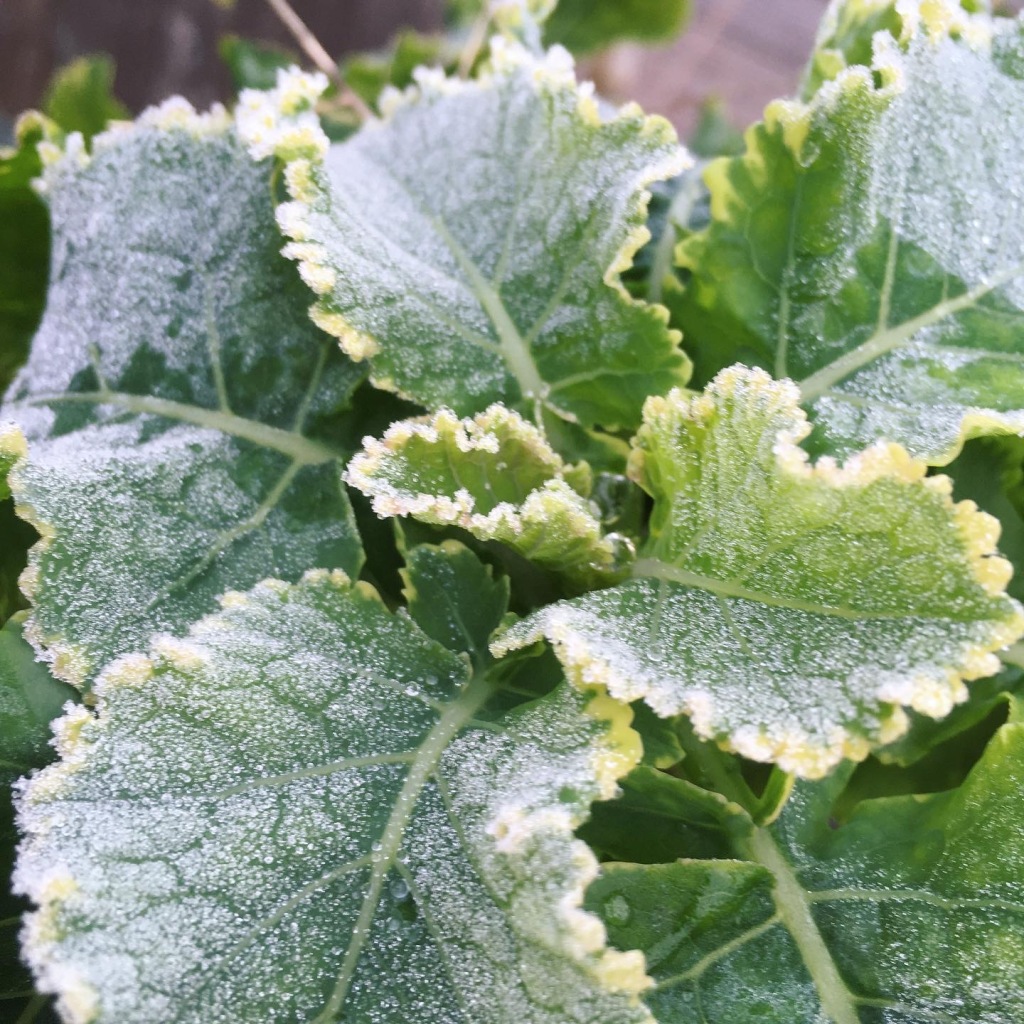
frost hardy Daubentons 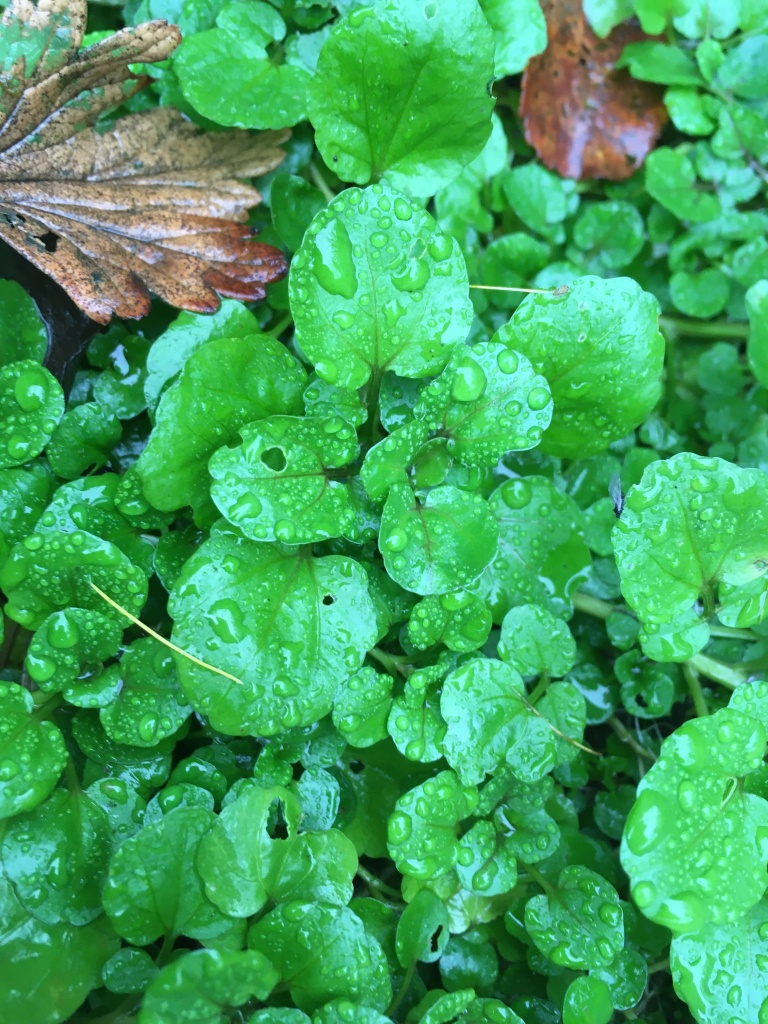
watercress 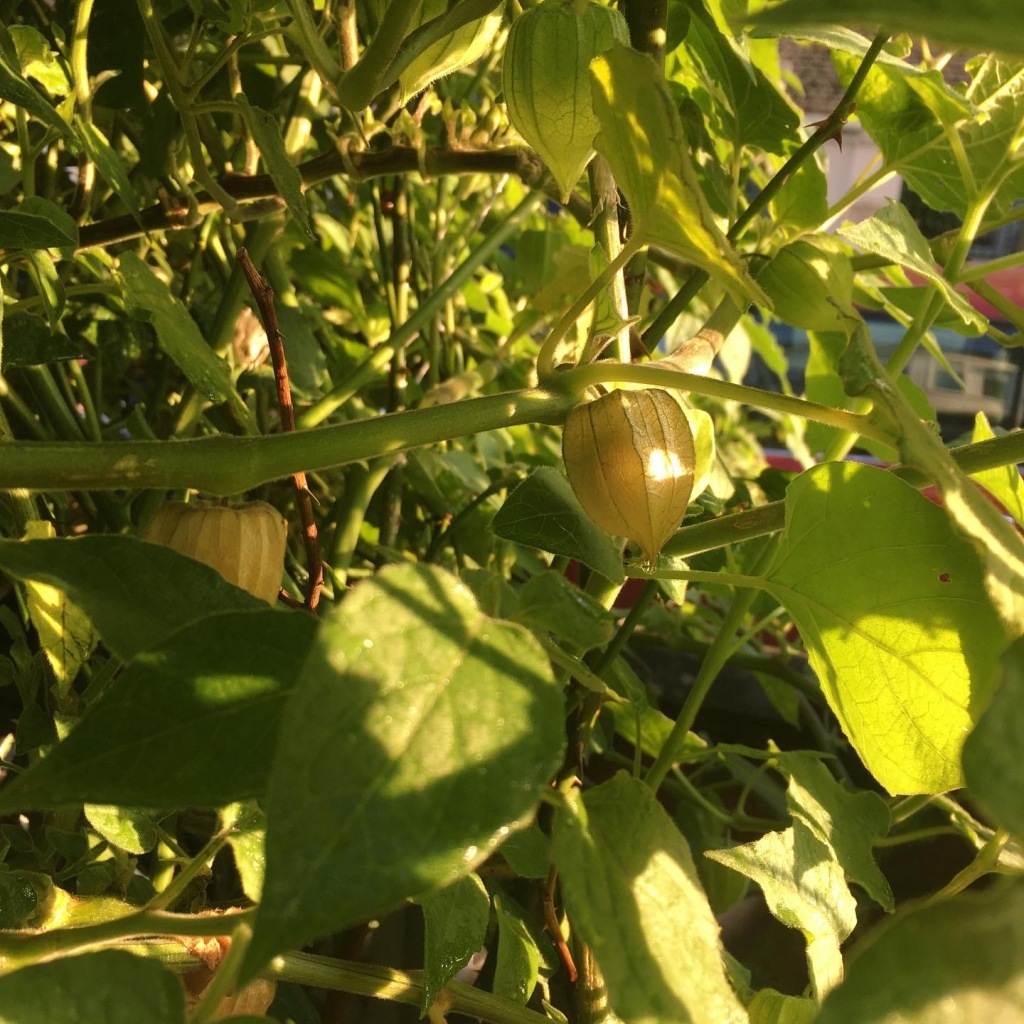
physalis 
our sparse three cornered leek patch 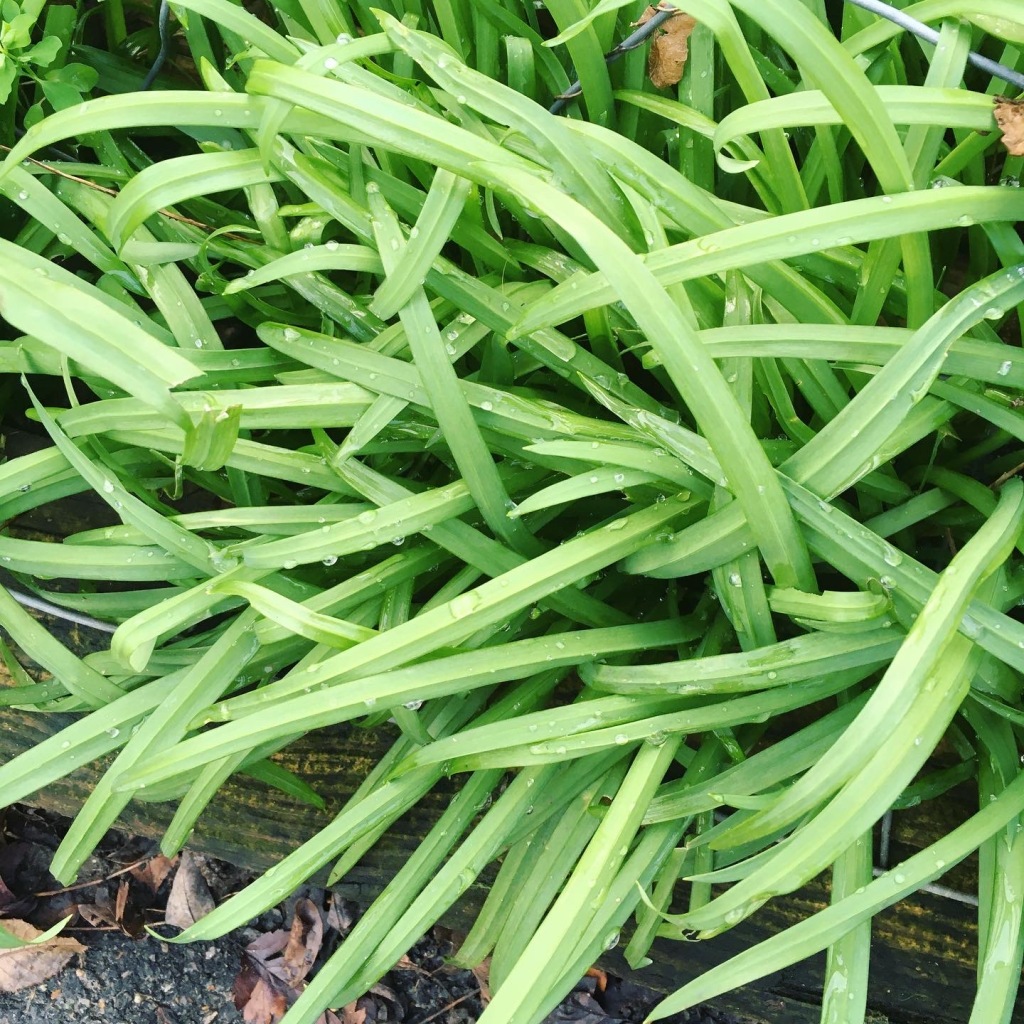
lush three cornered leeks in the park that we hope to get 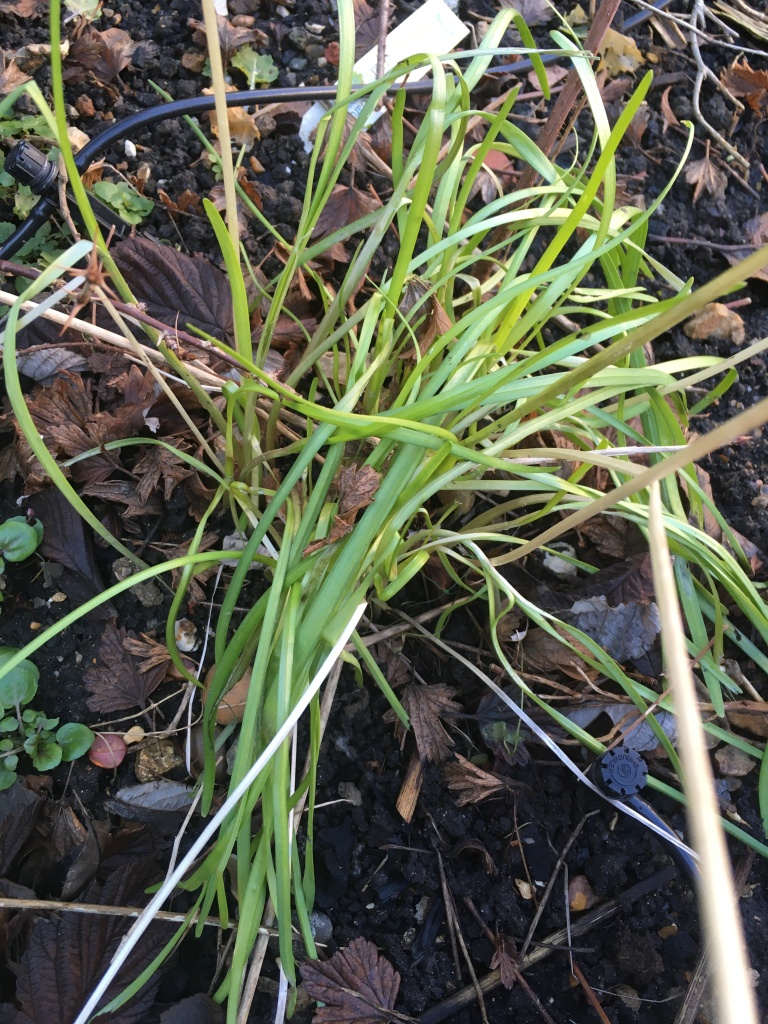
Chinese chives dying back
Perennials that need a bit of a hand:
These are root vegetables so need a hand because if you remove everything from the soil then there’ll be nothing next year. All the following 3 have the sugar inulin, so they can cause gas because they feed the gut flora – so a bad but good thing.
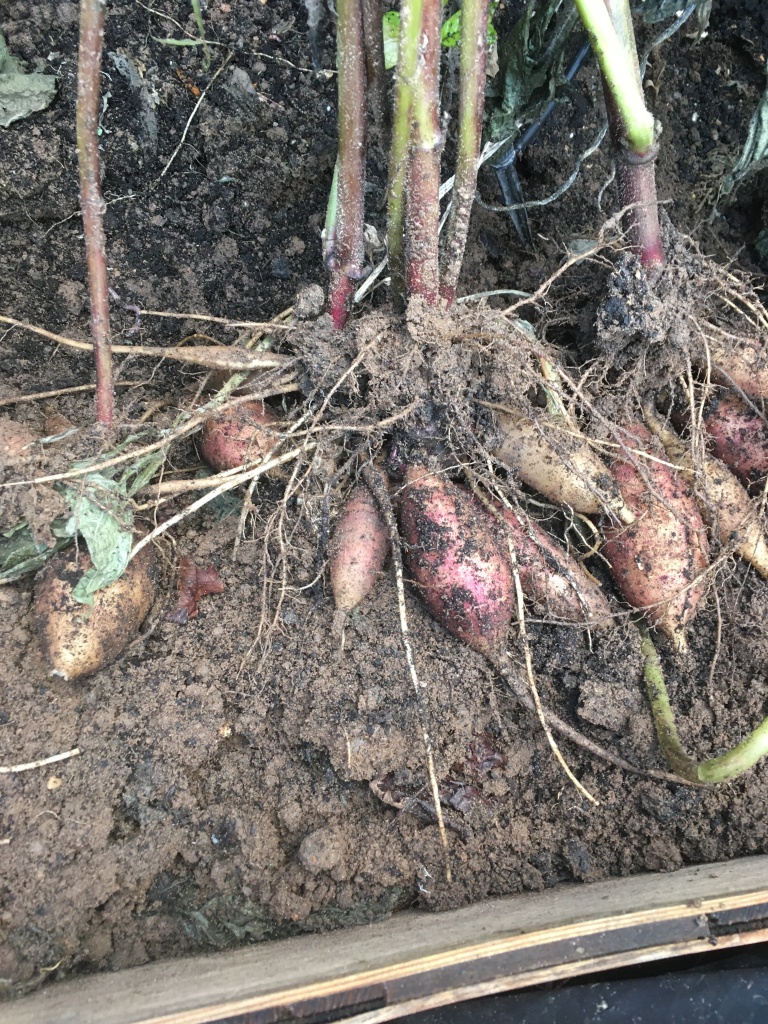
yacon 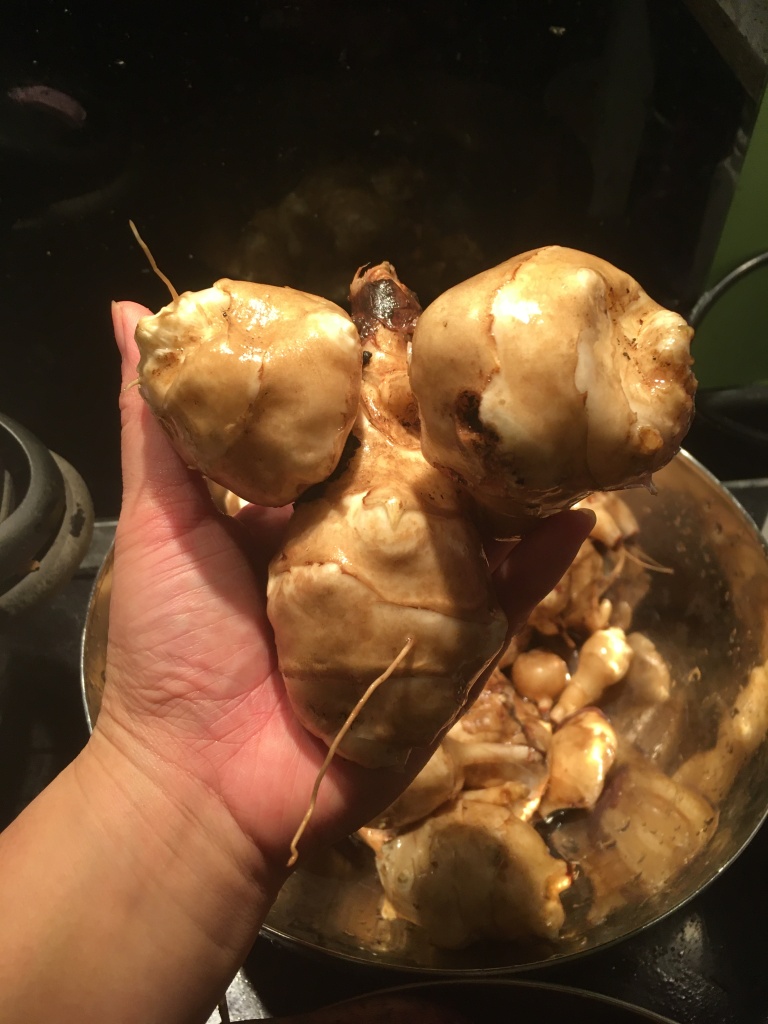
Jerusalem artichoke 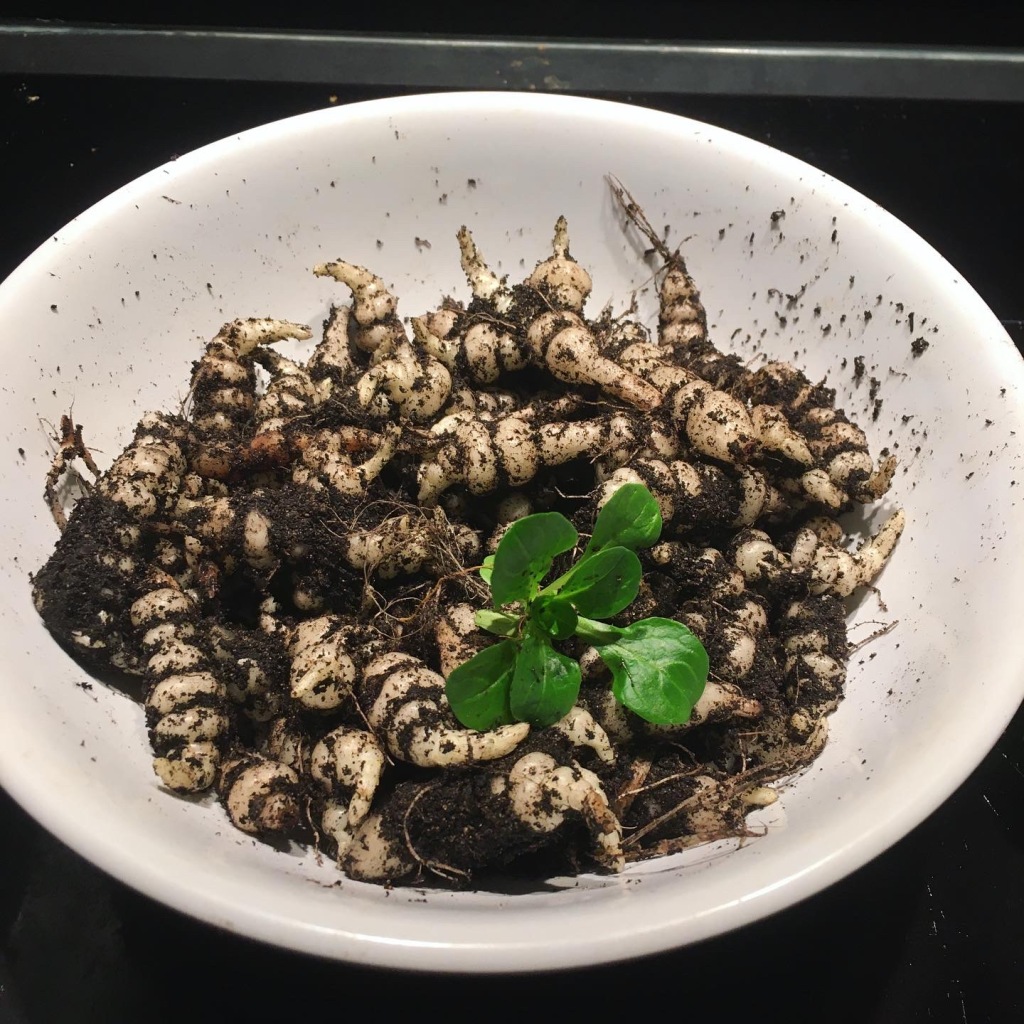
Chinese artichoke
Yacon – I only harvested this, this week. They’re can be really easy to pull up, root system and all, if the soil is friable. Raw tubers have a texture of water chestnut and a taste of carrot mixed with apple. They get sweeter when left on a sunny windowsill for a week. They can be stored in the ground (as long as the ground doesn’t become completely frozen) over winter and provide a decent amount of food. Little one loves them raw, but we don’t have many uses for them beyond that. They need peeling as the skin is bitter. They grow back from rhizomes (so you can eat all the tubers), which can be stored in a pot of compost somewhere sheltered. Click for more info.
Jerusalem artichoke – This is a new one for us this year. I was surprised at just how much food they produced for the amount of ground space needed. They do grow very tall though (ours were about 10 ft) so plan carefully where to grow them. They too can be stored in the ground (if there isn’t a hard freeze) and become sweeter with a frost. They also store fine in a fridge for a couple of weeks. The skins can be left on and they are lovely roasted or sauteed. You need to leave a couple of tubers to grow the following year. Raw they have a texture and taste a bit like nutty waterchestnuts. Cooked they are like potato and taste quite like steamed artichoke hearts. Click for more info.
Chinese artichoke – these are harder to harvest as they grow very deep down into the soil and are fairly small. It’s fun for the little one to dig and spot them though. This does mean that you are likely to have left tubers behind, so they’ll grow back easily the following year. The tubers look like tiny Michelin men and are very fiddly to clean. They have thin skin that doesn’t need peeling. Raw they taste and feel like waterchestnuts with a hint of mild radish. Cooked they are more like taro in taste and texture. Fiddly, but fun. Click for more info.
Self-seeding annuals:
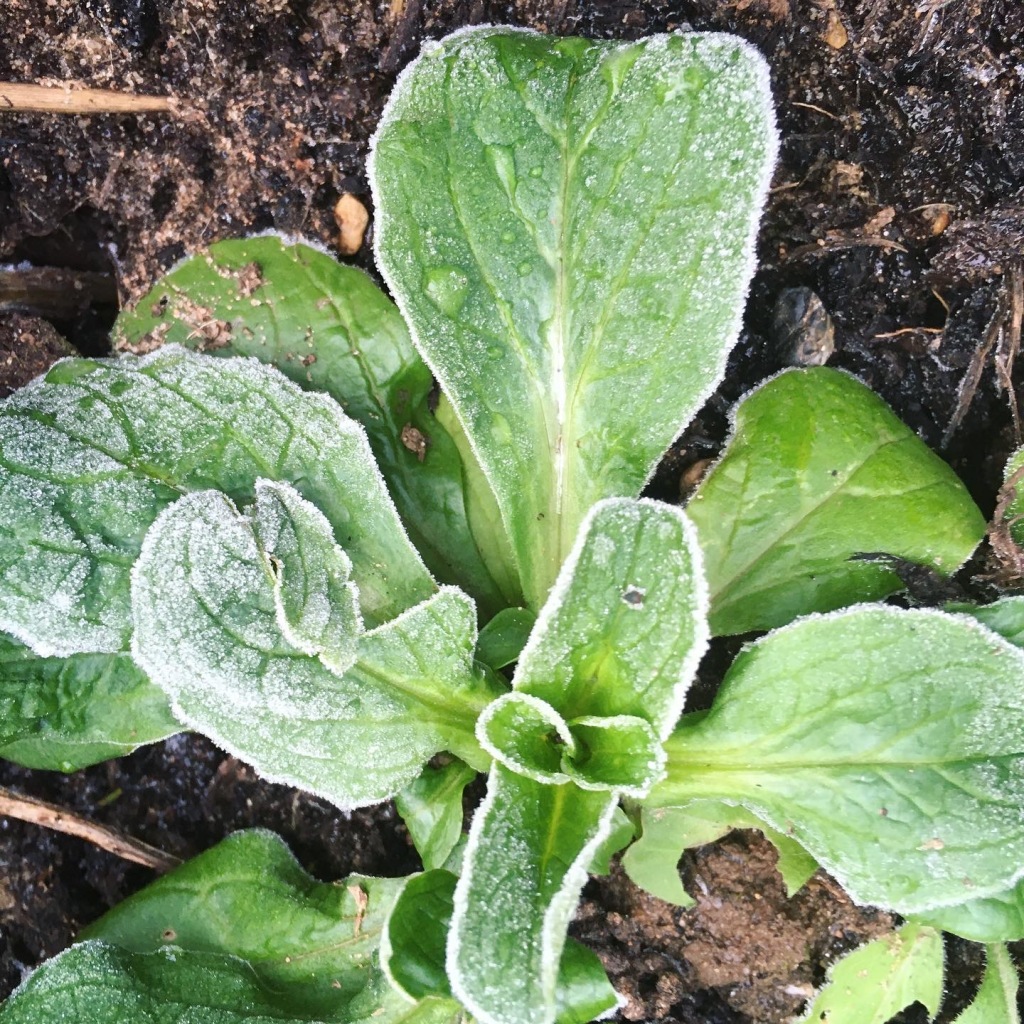
hardy lamb’s lettuce 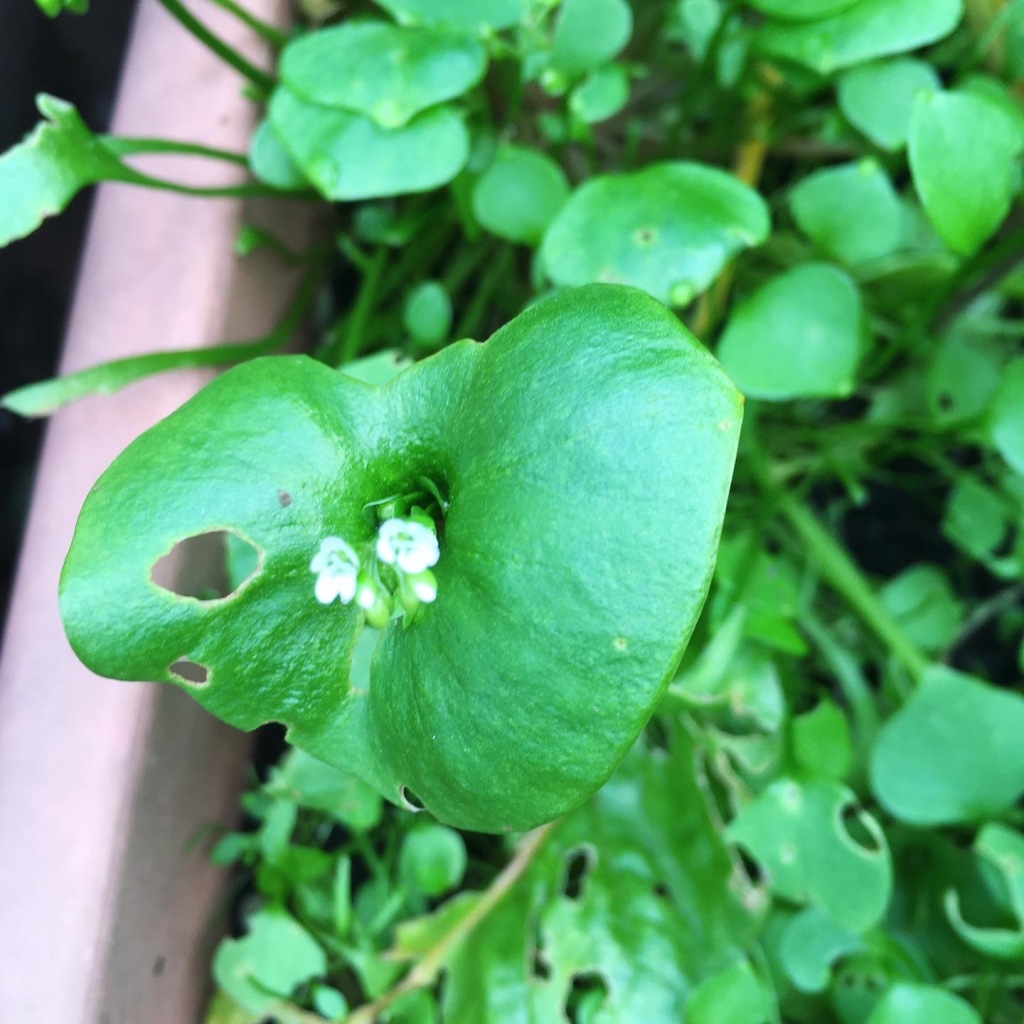
flowers of the winter purslane 
nasturtiums – taken just before the frost that killed them
Lambs lettuce – little one loves these as a salad leaf. The only reason I don’t grow more of it is that it forms very short plants, so they do take up a lot of soil space. A definite disadvantage in our small garden. Click for more info.
Winter purslane – eaten like lettuce, this also grows very short but it self-seeds so readily and grows so well under and around things that no matter how much we eat there is always plenty the next season. It is a bit fiddly to harvest though. Click for more info.
Nasturtiums – these are a fabulous plant to have in the winter. We have a trailing/climbing variety that uses the pear and apple tree to climb up. This is something we discourage in the summer, but in the winter when the leaves have all fallen and the fruit trees are dormant, we let the nasturtiums grow rampant and it’s a great non-brassica to have. Some of the plants will be ones that have grown through the summer and some of them will have grown from seed from September. They don’t deal well with frost so we must try and eat anything edible before the really cold weather to avoid waste. Click for more info.
Annuals:
All of the following are frost hardy and do well in the UK winters. The growth is slow though. If you plan it well you can have these almost ready as the winter starts and then the garden can act as a bit of a larder. Sadly, I didn’t plant many of them soon enough or in large enough quantities. I mostly waited to clear everything else before sowing them:
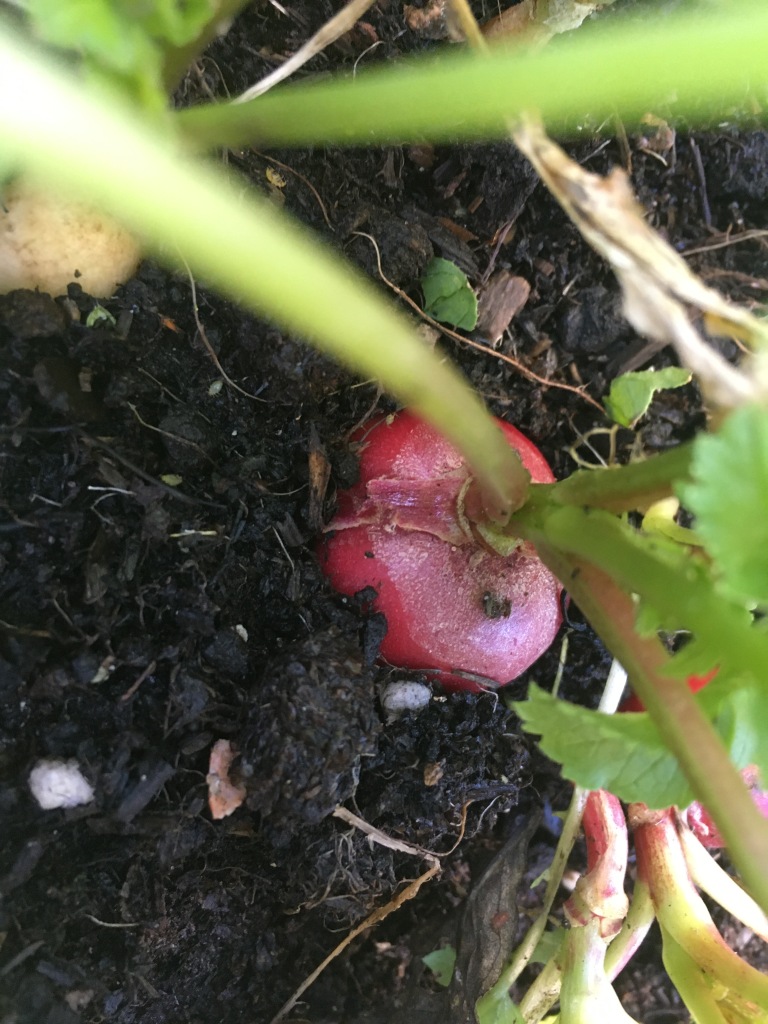
radishes still going today 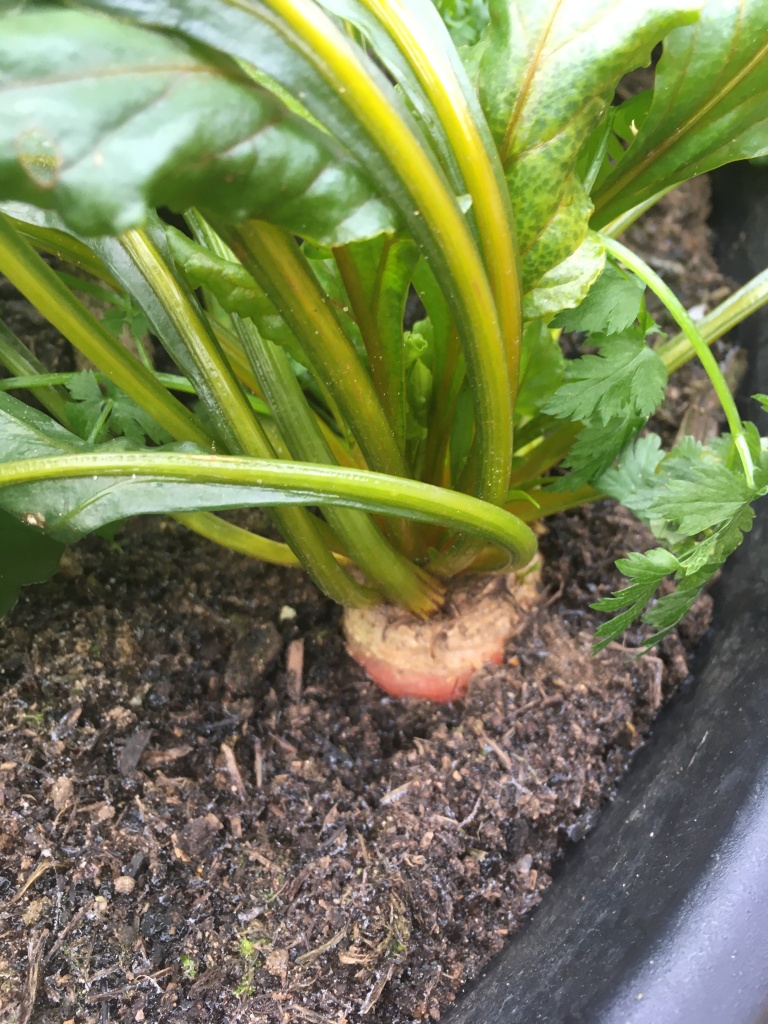
and beetroot 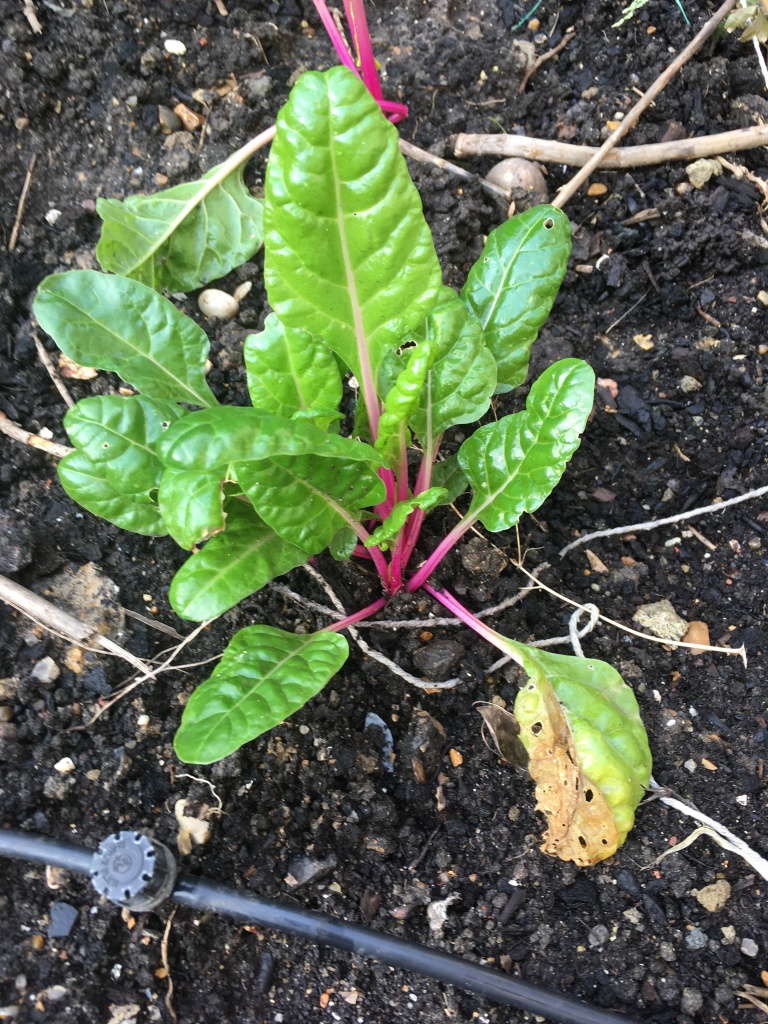
peppermint chard given to us from a neighbour 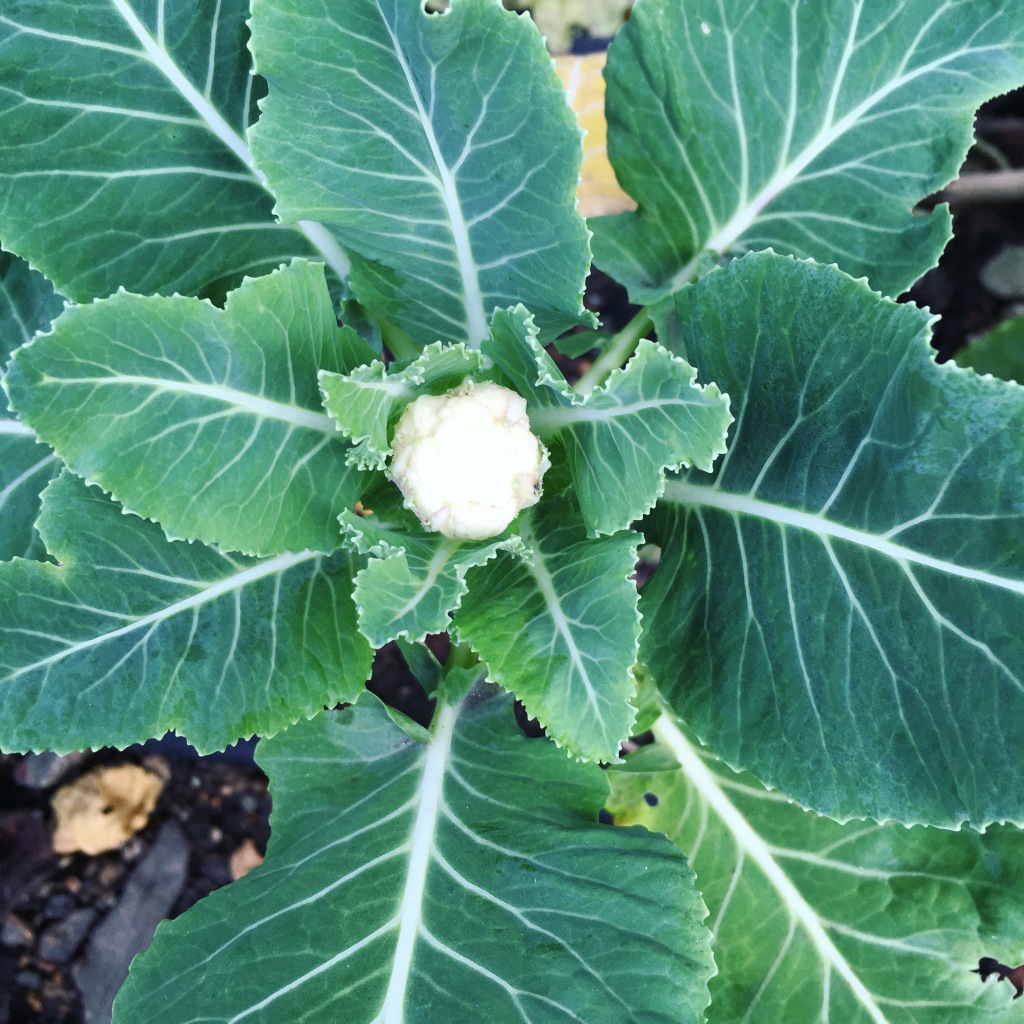
pathetically tiny cauliflower curds 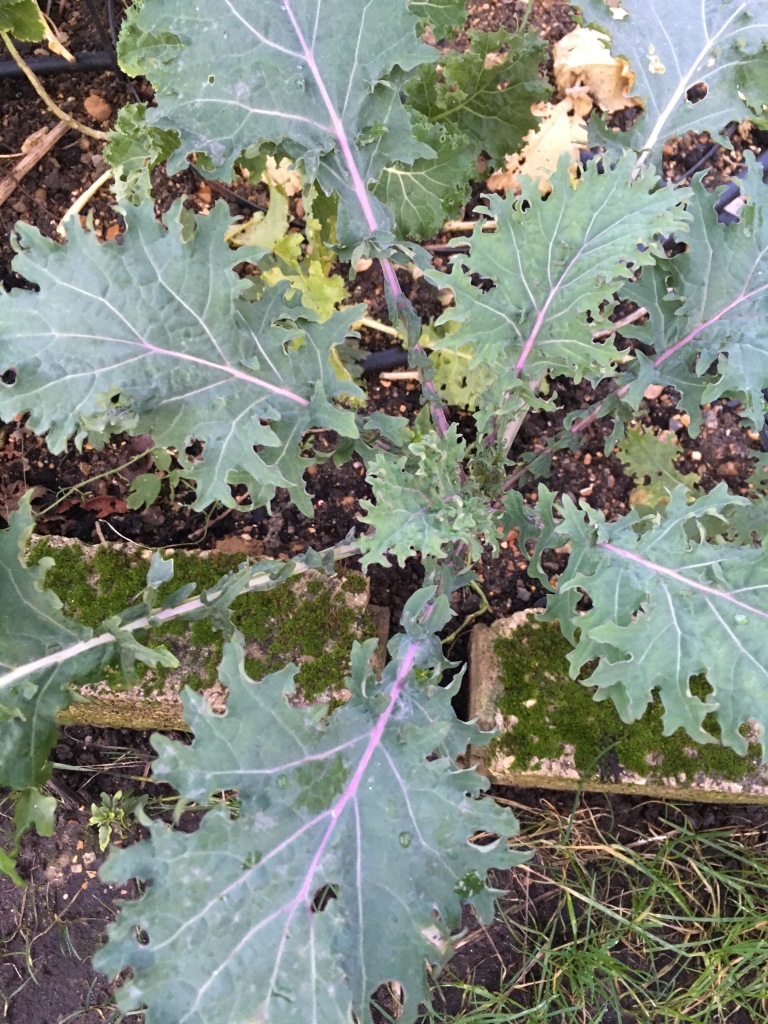
Red Russian kale
Radishes – generally grow quickly in warm weather, they need about 2 months to mature in late autumn. They haven’t grown much in the past month though. We also grow these for the greens overwinter. Click for more info.
Beetroots – we grow golden beetroots as they’re sweeter. Little one will only eat the yellow ones. We only have about 3 left in the garden. We should have planned better and sown more.
Chard – most of our plants are actually from a neighbour. They’re quite little so aren’t providing much now, but they should grow really well in early spring and be a welcome harvest in the hungry gap (April /May when there is little else available). Click for more info.
Cauliflowers – these were planted in too shady a spot and the curds are tiny.
Annual Kales – have Red Russian and Pentland Brig. These are still quite small but hopefully that means that they may still be going over the hungry gap.
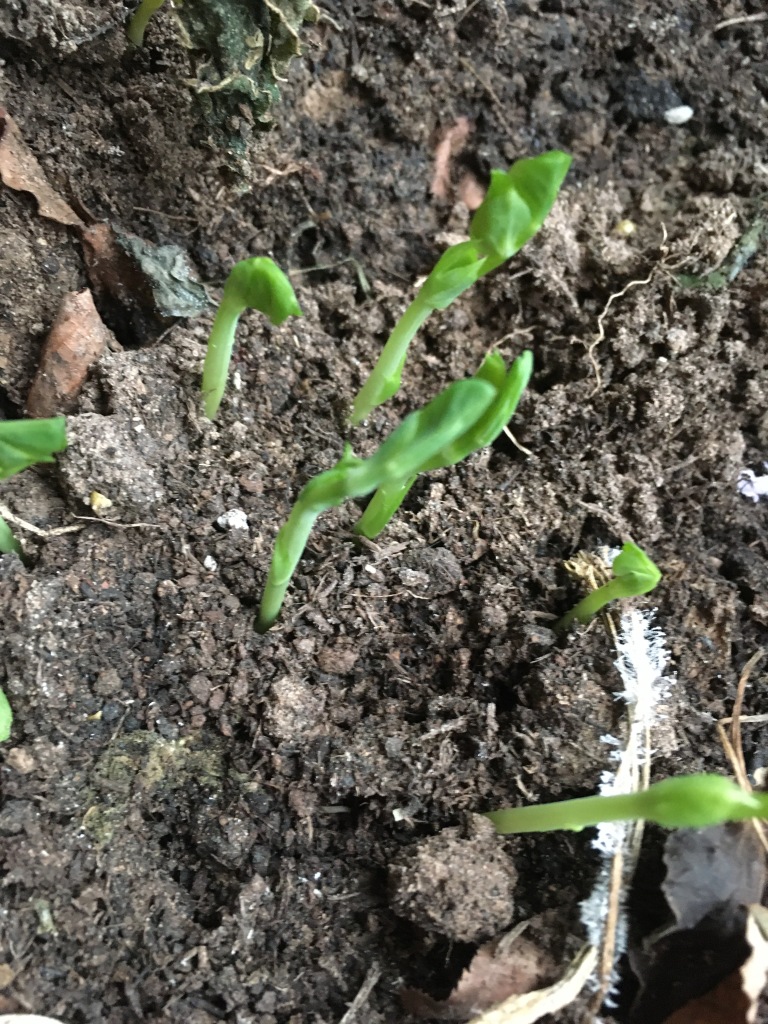
Indoors
Pea shoots – these can also be grown year-round indoors. It takes 4-6 weeks to get something to eat. These can be grown cheaply from supermarket dried peas. Click for more info.
Bean sprouts – these can be grown from dried mung beans year-round and only takes about a week. Click for more info.
Ideas for this year
Collards over kales – I’m sure the purple tree collard and the Daubentons will continue to thrive, but in order to keep producing lots of food over both winter and the hungry gap I think it’s work starting a couple more purple tree collards. 3 plants would provide enough for meals 3-5 times a week year-round. We might get a bit bored of it, but we’ll just have to find new interesting ways to cook it. It might also be a good replacement for a Daubentons. Whilst I love it for the tender tasty leaves, I’m fed up with dealing with the powdery mildew.
Grow food not lawns – To make the most of the space, I think it’s worth removing some of the patchy lawn (or just planting into the bare bits) to replace it with watercress, maybe try some landcress, Chinese chives and three-cornered leek. The Chinese chives and three-cornered leek thrive during opposite sides of the year so if I interplant them, the ‘grassy’ area shouldn’t get too bare. It’s worth sowing some winter purslane and lamb’s lettuce into this too. This means the area where the watercress currently is could support more chard, cauliflowers, or annual kale instead. These I’ll make sure I plant more of, and earlier than I did last year. Hopefully that means we’ll be covered in both winter and the hungry gap. We’ve tried growing edible flowers in the lawn but we’ve only managed to get a couple of each plants so far. We might also try some mint or lemon balm.
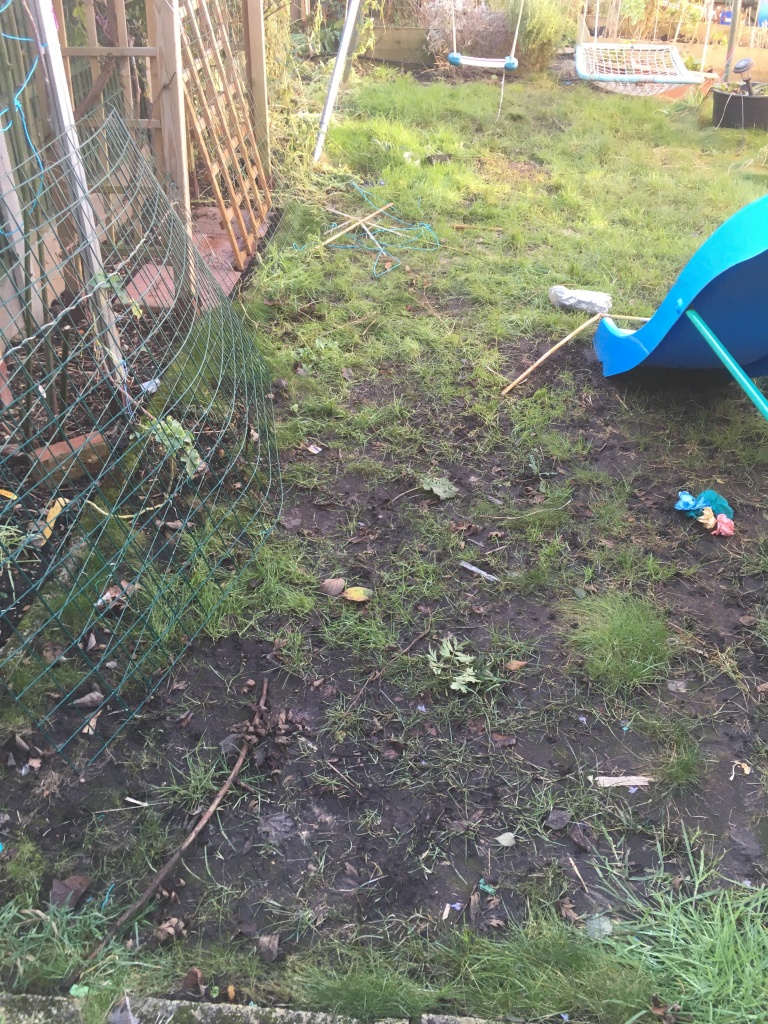
Lawn today 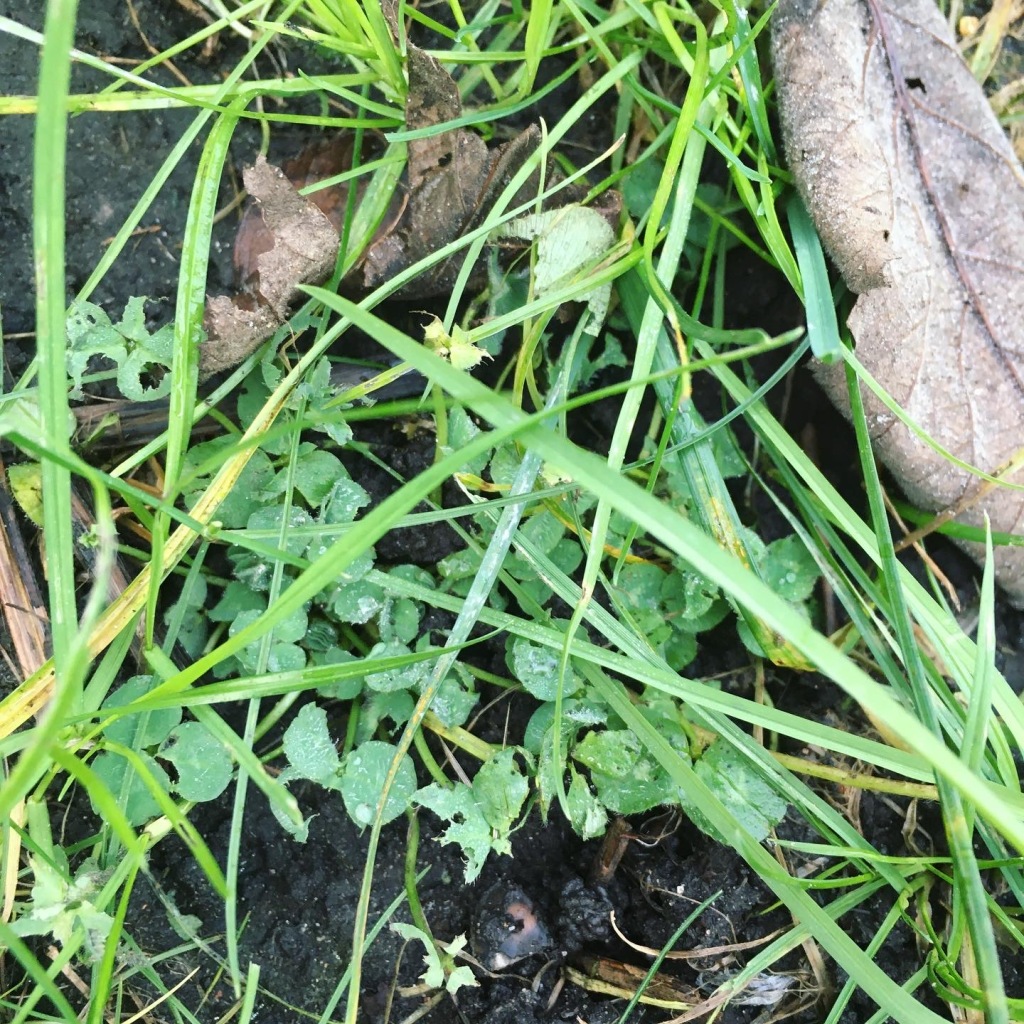
could also grow some purple clover for the edible flowers… 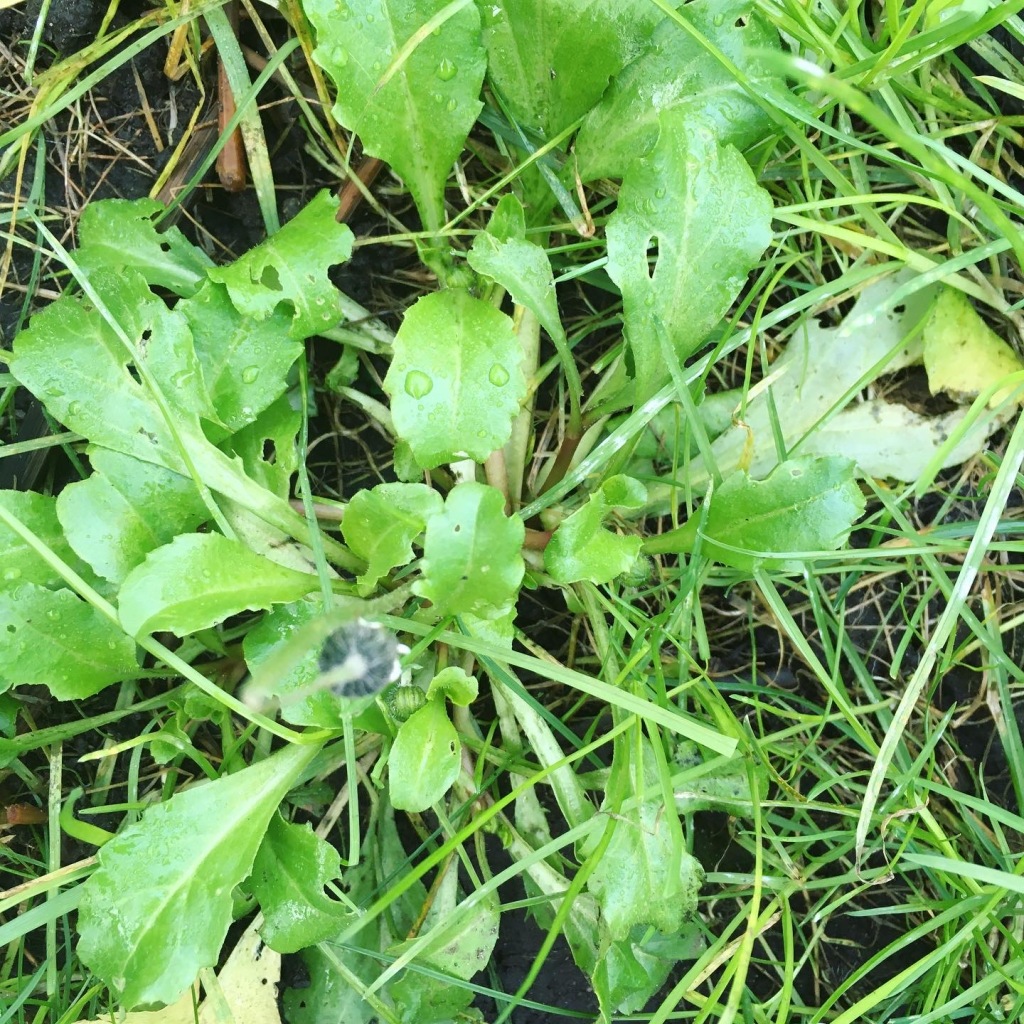
… and daisies are edible too 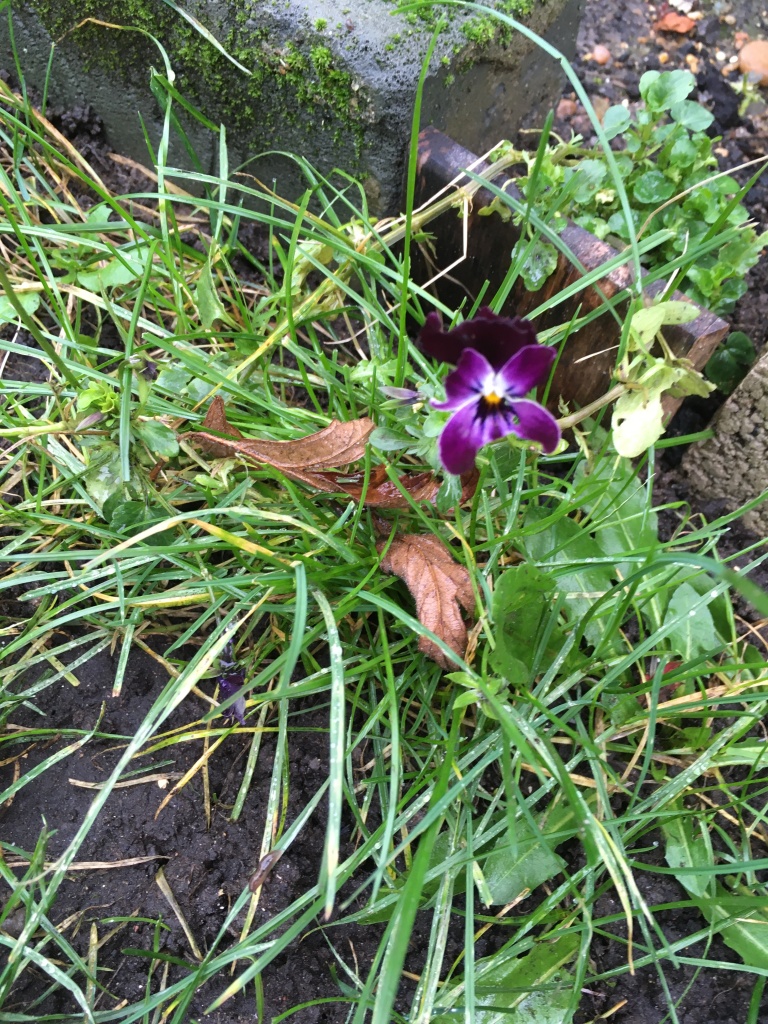
we could add some violets 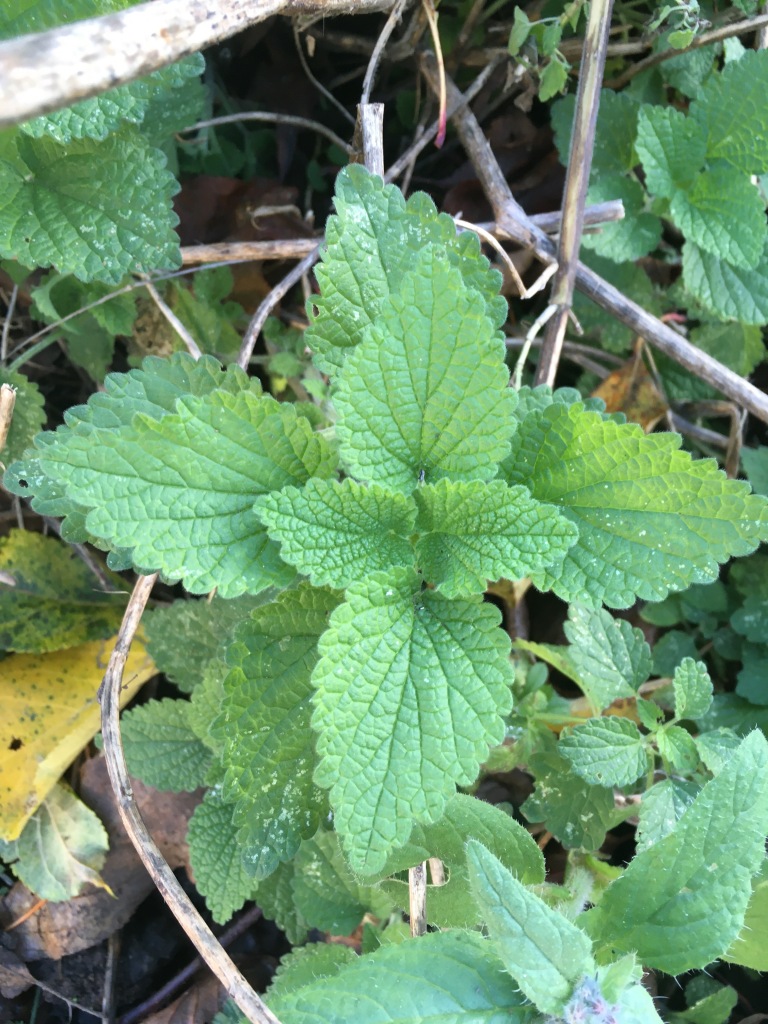
lemon balm might do well too 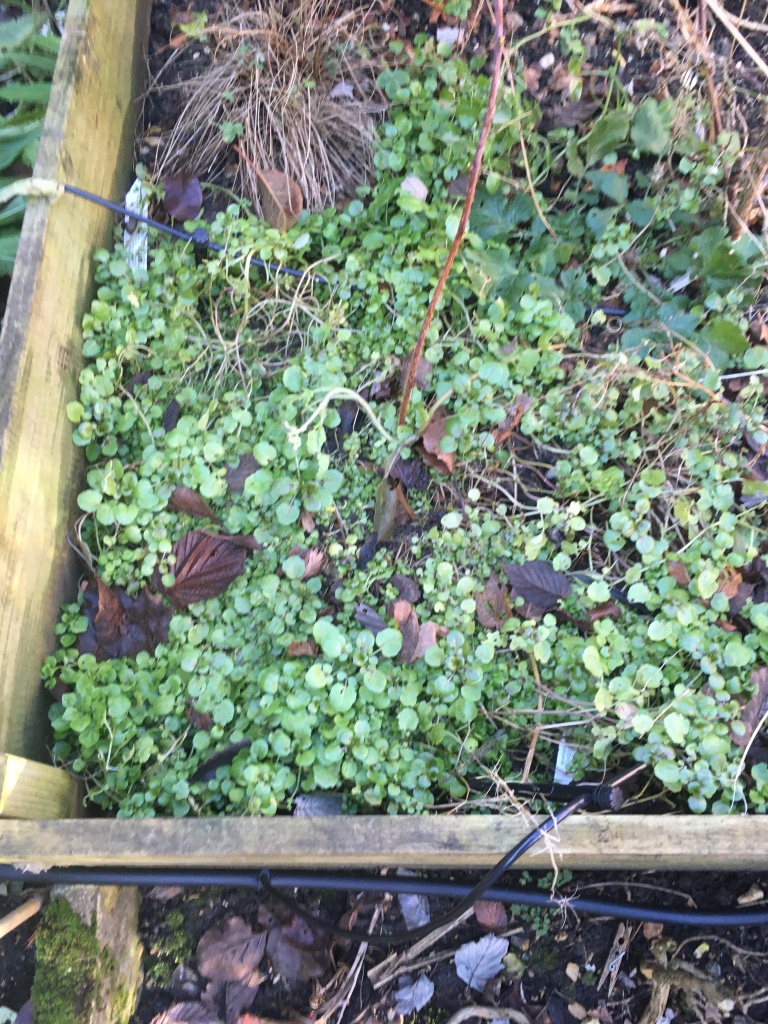
the space currently occupied by the watercress
Think ahead – In August September the garden is rather full and it’s hard to keep up with the harvesting so it’s hard to think of the leaner months, but this is when I need to sow more beetroots and chard to prepare for winter. More radishes need to be sown in early October so they can be harvested in December and then they can be left to provide greens over the later months.
Leaves – There’s a few new things I’d like to try this year. We have a muskmallow plant that still has some green leaves so maybe this year we could grow more, for the flowers in summer and for salad leaves in winter. My neighbour gave us some leeks in the last week of December. If they grow well in her garden, they’ll certainly be fine 4m away. I’m dying to try growing tatsoi and texsel greens too. I’ve never been particulary successful with Oriental leaves like pak choi, choi sum and kai lan. It’s always eaten by everything else in the garden, from pigeons to slugs. I think it’s time to give it another go.

muskmallow leaves 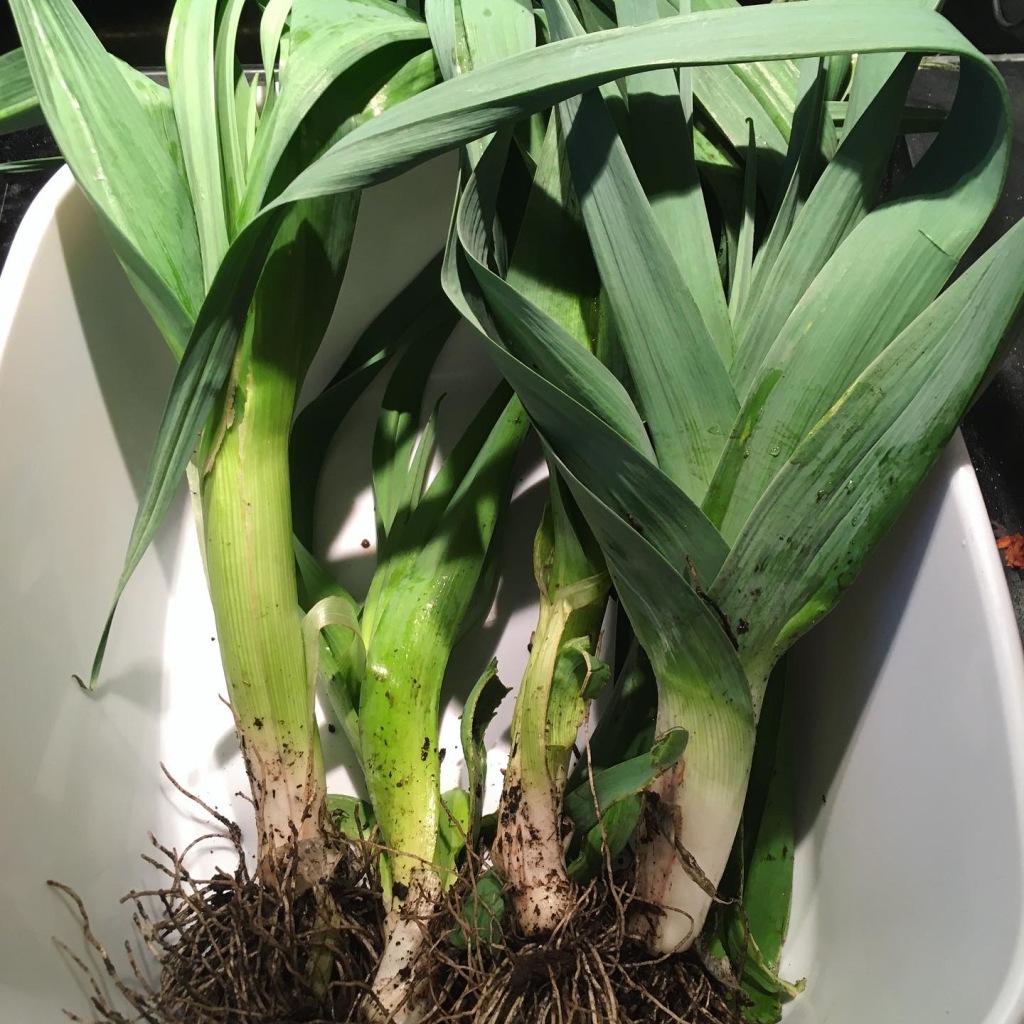
leeks from the neighbour 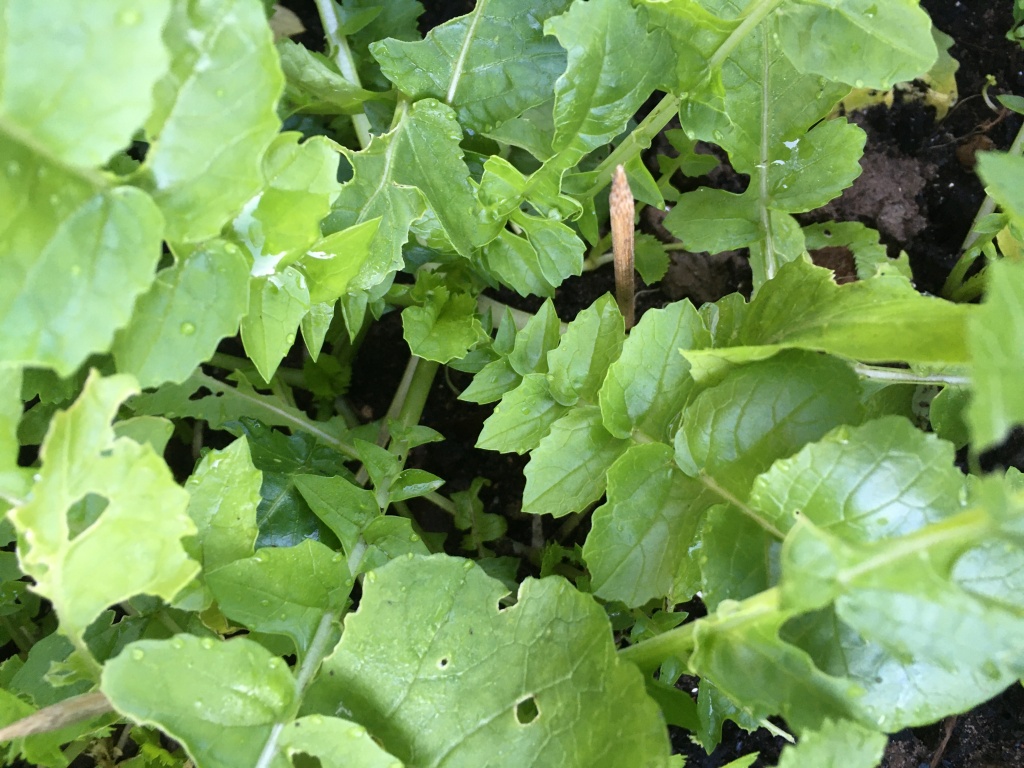
we should have started these daikon radishes earlier
Winter squashes – We’ve never really grown winter squashes to store. We’ve grown tromboncino, spaghetti squash, red kuri and pumpkin munchkins and have always eaten them young or soon after they’ve gone orange. This year we’ve ended up with a tromboncino and a few pumpkin munchkins left over that we just never got round to eating. Our garden is small, so we don’t tend to get much left over. This year I think we’ll put a few more supports in and grow a few more things vertically. We’ll leave more tromboncino and spaghetti squash to ripen and cure and I think we’ll try ‘Crown Prince’ squash this year too.
Maybe this time next year I’ll be able to update with an annoyingly smug post about our garden success… er that is… if home schooling hasn’t sent me mad by then.